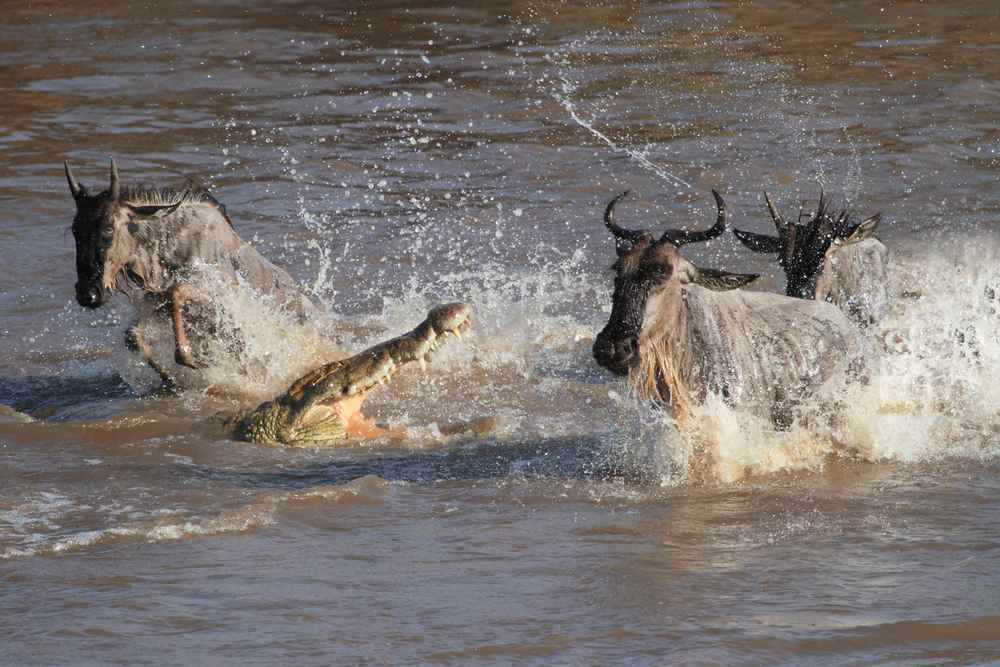The Great Wildebeest Migration

Introduction
The Great Wildebeest Migration is one of the most spectacular natural phenomena in the world. Each year, millions of wildebeests, accompanied by zebras and gazelles, embark on a circular journey across the Serengeti ecosystem in Tanzania and Kenya, driven by the search for fresh grazing lands and water. This epic migration, which covers a distance of approximately 800-1000 km, is a true testament to the resilience and adaptability of these animals. The journey is beset with challenges, from treacherous river crossings to the constant threat of predators. However, the wildebeests are guided by an innate survival instinct that has been honed over thousands of years.
The Migration Journey
The migration follows a fairly predictable pattern, with the herds moving in a clockwise direction through the Serengeti and Masai Mara. The journey begins in the southern Serengeti, where the wildebeests graze on the lush short-grass plains. As the dry season approaches, the herds move northward, crossing the Grumeti River in the western corridor of the Serengeti.
By July, the wildebeests reach the northern Serengeti and the Masai Mara in Kenya. This is often considered the best time to witness the dramatic river crossings, as the animals brave the treacherous waters of the Mara River, dodging hungry crocodiles and strong currents. As the dry season progresses, the herds continue to move northward, seeking out fresh grazing lands and water. By October, most of the wildebeests have crossed into the Masai Mara, where they remain until the onset of the rainy season. Witnessing this epic migration is a bucket-list experience for many safari goers.
Best Viewing Locations
The migration takes place across a vast area, but there are certain hotspots that offer the best vantage points:
Masai Mara National Reserve (Kenya): The Mara River crossings are the most famous and dramatic part of the migration. Strategically located camps and lodges provide prime viewing opportunities.
Serengeti National Park (Tanzania): The herds can be observed throughout the Serengeti, but the central and northern regions are particularly good for sightings during the migration.
Grumeti Reserves (Tanzania): These private concessions offer exclusive access to the Grumeti River crossings, which occur earlier in the migration cycle.
Best Time to Travel
The Great Wildebeest Migration is a year-round event, with different highlights and experiences depending on the season. However, the most popular and well-attended times are typically during the dry season. The timing of the migration is largely dictated by the rains, which can vary from year to year. However, there are certain periods that are generally considered the best times to see the migration:
July to August: This is the peak of the migration, when the herds cross the Mara River from the Serengeti into the Masai Mara in Kenya. The river crossings are a thrilling spectacle, as the wildebeest must brave crocodile-infested waters to reach the other side.
September to October: After crossing the Mara, the herds spread out across the Masai Mara, providing excellent opportunities to witness the migration in a more relaxed setting.
February to March: The migration calving season occurs in the southern Serengeti, as over 500,000 wildebeest calves are born within a few weeks. This is a magical time to witness the newborns taking their first steps on the lush short-grass plains.
Accommodation Options.
To make the most of your migration safari, it's important to choose the right accommodation. Options range from luxury lodges to mobile tented camps, each offering unique advantages:
Lodges provide comfortable amenities and reliable infrastructure, but may be further from the action.
Tented camps offer a more immersive experience and can be positioned closer to the migration routes, but have fewer creature comforts.
Some operators offer mobile camps that follow the herds, ensuring you're always in the heart of the action.
Conclusion.
Regardless of the time of year, the Great Wildebeest Migration is a truly awe-inspiring spectacle that should be on the bucket list of any wildlife enthusiast. With careful planning and expert guidance, travellers can maximize their chances of witnessing this natural wonder in all its glory. The migration is a testament to the resilience and adaptability of these animals, and a reminder of the delicate balance of nature that we must strive to preserve for generations to come.